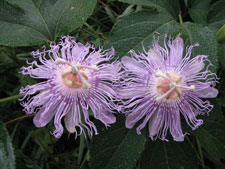Resource Library
Plant of the Week: Vine, Passion
The University of Arkansas System Division of Agriculture does not promote, support or recommend plants featured in "Plant of the Week." Please consult your local Extension office for plants suitable for your region.
Plant of the Week
[A-Z]
Passion Vine
Latin: Passiflora incarnate

If you have a passion for plants, how could you resist growing a passion vine? The flowers are bizarrely beautiful and leave you using all your fingers and toes as you count parts and try to fit this most unusual flower into the simplified floral diagram you studied in high school biology.
Maypop (Passiflora incarnata) is the most hardy of the almost 500 species of tropical passion vines that are found on every continent save Europe and Antarctica. The greatest concentration of species is in South America, but they’re found in Australia, here and there throughout the Pacific islands, in Africa and Asia. North America has nine species with maypop found as far north as the Ohio River Valley and points east.
It’s a fast growing perennial vine that quickly grows to the top of fences, over shrubs and even to the tops of small trees. It’s often found in disturbed places along roadways. The fast growing, rather unruly vines are supported by tendrils that occur opposite the three-lobed leaves that grow to 6 inches long.
The 3-inch diameter flowers are white to lavender or even purple in color. The name passion flower was first given to these plants by Spanish missionaries who used the visual imagery of the bloom to explain Christ’s crucifixion. The outer whorl of the flower has 10 elements and consists of five petals and five sepals. These elements, according to the legend, represented the 10 apostles who never doubted Christ.
The filigree of filaments is from the corona of the flower and represents the crown of thorns. The five anthers represented the five wounds; the three stigmatic lobes represented the three nails used to attach him to the cross.
Passion vine flowers are self-sterile and must be cross-pollinated by a bumblebee if the large, hen-egg sized fruit is to form. The fruit starts out green but turns yellowish to orange as it matures. The mucilaginous pulp on the inside of the fruit is edible and combines a unique sweet and sour taste said to be reminiscent of guava.
William Strachey, in his 1612 report to the Virginia Company later published as The Historie of Travaile into Virginia Britannia, reported that the native Americans of the Jamestown area were growing maypop in their gardens and described it as being “a good, summer-cooling fruit.” The passion fruit commonly grown for juice production is the Brazilian species P. edulis, but many other species are used locally for juice.
Passion vine is an interesting addition to the garden, but its unruly ways make it best suited for out-of-the-way corners of the garden where it can be allowed to scamper across the ground, over adjacent shrubs or along fences. Because its vines die to the ground every winter, cleanup from chain-link fences could be a hassle. It’s a good choice for the wild garden and edge-of-woods locations.
Blooms are produced most of the summer along the length of the stem. Individual blooms remain open only one day. The fruit ripen over the summer and are ready to sample when they change color and begin drying out.
This fast growing vine is hardy from zones 6 to 10 and may survive even further north if given a thick winter mulch. Vines will grow 12 feet or more in a season from well established plants. Because of its tendency to grow in every direction, clipping and/or directing the vines as they appear in late spring will keep it tidier. It’s at its best in full sun to light shade in a moist, but well drained soil. They’re intolerant of heavy clay soils.
This native vine is the caterpillar host to the gulf fritillary and a few closely related butterfly species. Gardeners interested in attracting this beautiful orange butterfly to the garden always include a maypop vine somewhere in the garden.
By: Gerald Klingaman, retired
Extension Horticulturist - Ornamentals
Extension News - August 8, 2008
The University of Arkansas System Division of Agriculture does not maintain lists of retail outlets where these plants can be purchased. Please check your local nursery or other retail outlets to ask about the availability of these plants for your growing area.